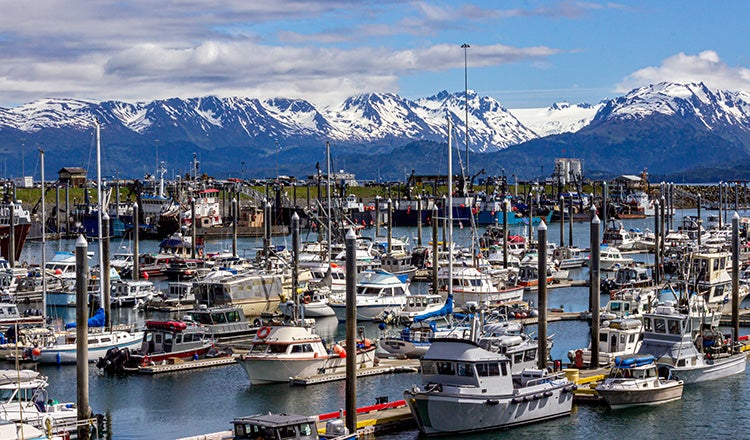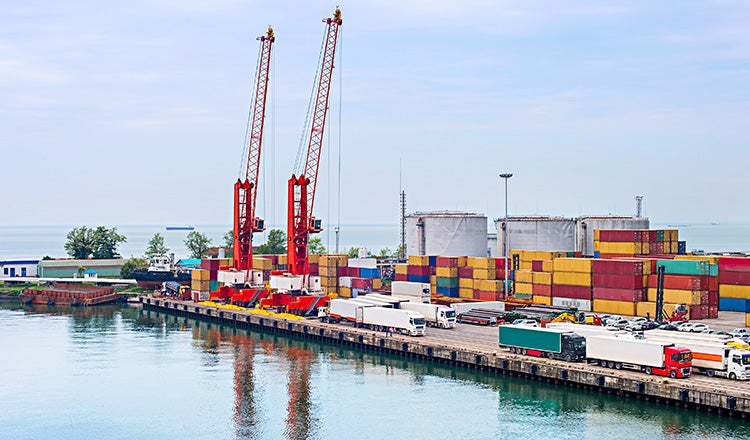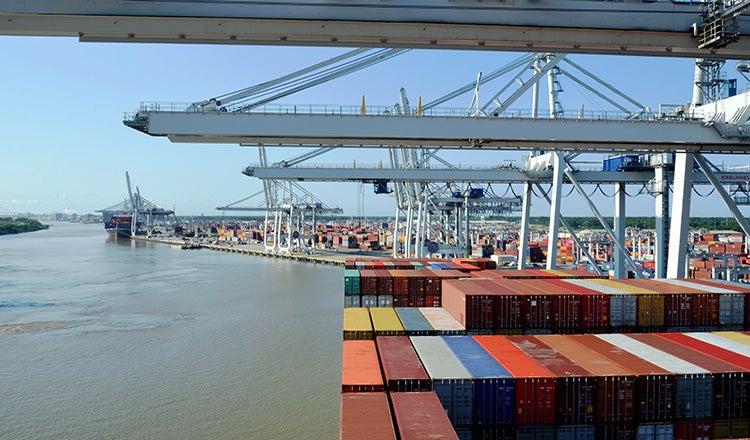
Securing Federal Grant Resources for U.S. Ports
Leveraging IIJA Funds to Deliver Crucial Solutions for Ports
By Nathan Macek, Aurah Landau and Kevin Keller
Like many ports, the Alaskan Port of Homer faces aging infrastructure and capital needs well beyond the local funding capacity. The port is a key link in the supply chain for 47 remote, rural, disadvantaged or Alaska Native communities served by Homer, making proposed port infrastructure upgrades critical for shipping statewide as well as for the local community.
Enter the Infrastructure Investment and Jobs Act, also known as the Bipartisan Infrastructure Law. This unprecedented influx of federal funds has provided ports in the United States a significant opportunity to make much-needed improvements. From coast to coast, at inland ports and intermodal facilities in between, ports are taking advantage of funding to plan and construct more resilient facilities and infrastructure, reduce emissions, and enhance intermodal connectivity.
But it’s not as simple as filling out an application form. Though federal funding levels in IIJA have increased, competition for grant awards is intense, with demand far exceeding available funds. Transportation infrastructure owners/operators who are successful at obtaining federal funding know that strategic planning must begin well before a notice of funding opportunity is released. Proactive infrastructure owners and operators invest in master plans and are prepared to justify the need for their project before the NOFO is published and a grant application is prepared.
The Port of Homer has positioned itself strategically using a methodical process to align capital projects to specific federal grant programs and produce the most competitive grant application possible:
- Assess a project’s readiness, eligibility, and merit
- Align it with a grant program
- Invest in project development
- Prepare a standout application

1. Readiness, Eligibility, Merit
Infrastructure owners should begin with the key documents that establish readiness, such as a master plan or capital improvement program. When evaluating upcoming grant opportunities, port officials can compare the requirements to the projects identified in the plan and identify the best grants to pursue. A master plan also helps the owner take a programmatic approach — organizing projects by need and grouping similar projects to maximize available funding.
Long before the NOFO is released, an owner should begin the pre-positioning process — a deliberate approach to ready projects for grant application. This begins with evaluating projects identified in the master plan to match them to available grants, then prioritizing projects based on readiness, eligibility and merit.
Project steps that should be complete before the NOFO is released include engineering, cost estimation, environmental clearance, and other project development activities to advance project readiness; preparing an initial benefit-cost analysis, a frequent requirement for many grant programs; lining up political support; and registering for grant information on the websites Grants.gov and Sam.gov.
This kind of pre-positioning work can increase grant award success, identify funding streams and allow for greater emphasis on performance measurement.
REM Tool: Selecting a Grant Program
For larger ports with several projects in the planning stages, HDR has created a Readiness, Eligibility and Merit tool to help owners/operators assess and prioritize projects for federal grant funding. The REM tool evaluates a variety of inputs to assess the competitiveness of individual projects in a capital program based on federal funding requirements. The results help an owner prioritize which projects to apply for grants now, and which to invest in additional project development activities to better prepare the project for consideration in a future year based on specific grant program requirements.
2. Aligning a Project to a Grant Program
An array of grant opportunities is available to ports and intermodal facilities, and successful applicants will carefully choose the appropriate program. The HDR infrastructure finance team has created a system to compare grant opportunities and identify the best programs to meet a project’s needs. This assists ports in pursuing applications likely to have a greater chance of award.
Consider the Port Infrastructure Development Program. Eligible projects for this program must do the following:
- Improve the safety, efficiency or reliability of the movement of goods, operational improvements (including resiliency), or environmental and emissions mitigation
- Provide shore power to cruise, ferry and cargo vessels
Grant funds cover the planning, environmental review and final design of eligible projects.
Before applying for PIDP, or any grant program, consider: Does the project fit the criteria? What are the proof points, both qualitative and quantitative, that objectively demonstrate the project fits?
If a project doesn’t fit into these categories, don’t shoehorn it. Find a grant program that aligns with the project’s goals. Other programs to consider are RAISE, INFRA or Mega. (See below for a list of grant programs to consider.)
Also consider what stages of project development a grant will fund. If a project is in the planning stage, but a grant only funds design or construction, it is not the appropriate grant. It’s best for ports to submit only one project per grant program each year to maximize chances for success. A benefit-cost analysis is key, as it shows the merits of the project.

3. Invest in Project Development
If a project is not at the right stage of development for a grant, another option is to invest in project development to help with grant positioning.
Many federal grant programs require a project to have completed a certain amount of planning. For example, some require planning to be complete. Others want to see environmental work or design. Port leaders must know what phases are covered by the grant, what needs to be complete and by when it should be done.
4. Strong Grant Applications
A grant application tells the story of why a community needs and deserves federal funding for its project. Ports can gather data to show the importance of their freight movement to the local or regional economy. This builds the case via the benefit-cost analysis. The BCA is key in demonstrating the need for the project.
A strong grant application also includes:
- A complete description of the project: goals, purpose and need, implementation
- Clear alignment with the grant program’s merit criteria
- A well-articulated statement of work with specific scope, schedule, and budget
- A clear, cohesive, and complete narrative
- A BCA demonstrating positive public economic and societal outcomes (ratio greater than 1.0) that fully meets grant requirements, when applicable/required
- Matching state, local, or private cash contributions that exceed the proposed federal grant program requirements — preferably including private-sector contributions
- Strong, specific support for the project from one or more private partners, senators or congressional representatives and from the governor’s office
Ports around the United States are eligible for funding that can help them modernize their facilities and energize their regional economies. Take advantage of this once-in-a-generation funding opportunity by following our grant-winning approach.

Case Study: Georgia Ports Authority
With HDR’s assistance, the Georgia Ports Authority received four grants between 2017 and 2023, totaling $140 million to support $570 million in project costs. This includes one FASTLANE grant, one INFRA grant and two Port Infrastructure Development Program grants. With this funding the port authority has been able to finish key projects including reconfiguration of the Port of Savannah’s on-dock intermodal container transfer facilities.
The ports authority found success by tailoring its projects to the requirements of the grant programs. For example, for the Colonel's Island Terminal needed to increase capacity for cargo. Our team along with the port authority assessed several grant programs and selected the PIDP as the best fit. However, the project did not fit the requirements. So we proposed tailoring the project to better suit the benchmarks in the program. The port authority added a livability improvement by removing some at-grade rail crossings on local arterial streets. This meaningful upgrade to the local community increased the cost but also greatly increased the project’s likeliness of obtaining grant funding.
Another key area to look at is sustainability and resiliency. Many grant programs include those areas as a requirement. Owners should consider whether their project can include an element of reducing emissions or decreasing waste streams, depending on the grant program selected.

Case Study: Port of Homer
The State of Alaska transferred the Homer Port to the city in 1999, leaving the local community responsible for extensive deferred maintenance. Some floats were already 10 years beyond design life at the time. State maintenance funds were not made available upon transfer, and the city assumed ownership without replacement reserves, which under best practices would have been accruing at 2.5% to 5% of the asset’s value throughout its intended life cycle. The floats are now 37 to 60 years old, well past their designed service life of 25 years.
To pursue funding to address these needs, HDR worked with the City of Homer to develop a comprehensive multi-year grant strategy that complements the port’s capital improvement plan. HDR and Homer staff reviewed documents related to project scope and benefits, funding sources, project and city financial plans, community planning, and public engagement to identify project characteristics and funding plans. The team matched capital improvement plan projects with federal discretionary grants and other funding opportunities, developed funding recommendations and actionable work plans for each project and group of projects, provided a schedule of application/funding activities by year, and documented and presented findings.
The group made recommendations based on project specific analyses combined with HDR’s knowledge of federal grant programs, analysis of recent NOFOs, fiscal year 2022 award announcements including HDR-supported wins, and discussions with federal agency staff.
These insights were used to assess the readiness of projects and the presence of merit elements in the projects, with the goal of determining the optimal alignment between projects and available grant opportunities. From there, the City of Homer staff prioritized projects for various grant applications based on available workload and political priorities to the community.
This thorough approach gave the city the tools it needed to be purposeful in addressing the port’s capital needs. The city has already submitted one Port Infrastructure Development Program grant and is positioned for other prospects to capture funding.
Grant Opportunities to Consider
- PIDP – Port Infrastructure Development Program: Administered by the Maritime Administration, this federal grant program provides funding for port and intermodal infrastructure projects, including the construction and rehabilitation of marine terminals.
- Reduction of Truck Emissions at Port Facilities Program: This program aims to reduce truck emissions at port facilities. FHWA will coordinate and provide funding to test, evaluate and deploy projects that reduce port-related emissions from idling trucks, including through the advancement of port electrification and improvements in efficiency, focusing on port operations, including heavy-duty commercial vehicles, and other related projects.
- RAISE – Rebuilding American Infrastructure with Sustainability and Equity: This U.S. Department of Transportation program provides funding for transportation projects that have a significant regional or national economic impact and includes a category for port infrastructure projects. It prioritizes projects with benefits in the areas of safety, sustainability, quality of life, mobility/connectivity, economic competitiveness, state of good repair, partnership and collaboration, and innovation.
- PROTECT – Promoting Resilient Operations for Transformative, Efficient, and Cost-saving Transportation Program: PROTECT is a competitive discretionary grant program through the Federal Highway Administration. It funds projects that make transportation infrastructure more resilient to natural hazards and the effects of climate change, including severe storms, flooding, drought, levee and dam failures, wildfire, rockslides, mudslides, sea level rise, extreme temperatures, and earthquakes.
- Port Security Grant Program: This grant program supports the development and implementation of security measures at critical infrastructure sites, including marine terminals. It could include surveillance cameras, new control systems, implementation of cyber security protocols, or advanced emergency response technologies. To be eligible for Port Security funding, applicants must demonstrate that their proposed security measures will enhance the safety and security of their facility.
- INFRA – Infrastructure for Rebuilding America: This federal grant program provides funding for infrastructure of national significance, which could include improvements to container wharves. Eligibility requirements for INFRA funding include demonstrating that the project has significant national or regional economic benefits and that it addresses a critical transportation need.
- Mega – National Infrastructure Project Assistance Program: This program supports large, complex projects that are difficult to fund by other means and likely to generate national or regional economic, mobility or safety benefits.
- FEMA BRIC – Building Resilient Infrastructure and Communities: Aims to categorically shift the federal focus away from reactive disaster spending toward research-supported, proactive investment in community resilience. Projects must reduce or eliminate risk from natural hazards through infrastructure projects, policy development or workforce enhancements.
- FRA CRISI – Consolidated Rail Infrastructure and Safety Improvements: Invests in projects to improve railroad safety, efficiency and reliability; mitigate congestion at intercity passenger and freight rail chokepoints to support more efficient travel and goods movement; enhance multimodal connections; and lead to new or substantially improved intercity passenger rail transportation corridors.
- USDOT SMART – Strengthening Mobility and Revolutionizing Transportation: Provides grants to conduct demonstration projects focused on advanced smart city community technologies and systems in a variety of communities to improve transportation efficiency and safety.






